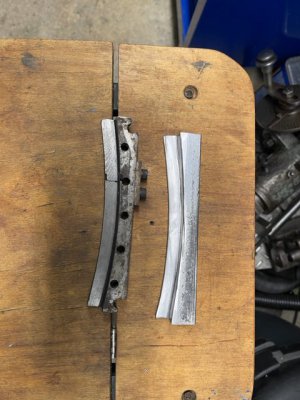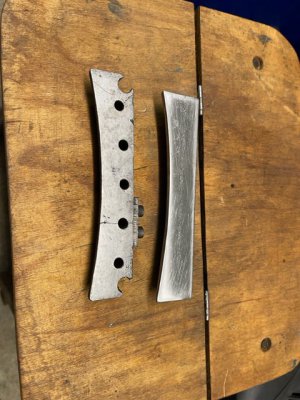jbacc
Hot Rolled
- Joined
- May 5, 2009
- Location
- New Jersey
Good Morning, All,
I am moving forward cleaning and repairing my recently acquired K.O., Lee B960 T&C Grinder. I came a cross a part that locks the swivel table down that is cracked and was some what repaired. Adise from it being cracked some of the holes for the table locks are also cracked so I am considering making a new part.
My challenge is how to make the curved/radius cut on the part? I can't seem to duplicate it using my rotary table. I even tried a boring bar in a boring head on my mill and again, I could not duplicate the radius. I have lathes, band saws (vertical & horizontal) a Bridgeport Mill and a K&T horizontal mill but for the life of me, I can't figure out how to duplicate the radius with what I have.
I apologize in advance if this should be a no brainer but I am stumped and appreciate any assistance, comments, guidance that any of you are willing to share.
Thank you,
Joe
I am moving forward cleaning and repairing my recently acquired K.O., Lee B960 T&C Grinder. I came a cross a part that locks the swivel table down that is cracked and was some what repaired. Adise from it being cracked some of the holes for the table locks are also cracked so I am considering making a new part.
My challenge is how to make the curved/radius cut on the part? I can't seem to duplicate it using my rotary table. I even tried a boring bar in a boring head on my mill and again, I could not duplicate the radius. I have lathes, band saws (vertical & horizontal) a Bridgeport Mill and a K&T horizontal mill but for the life of me, I can't figure out how to duplicate the radius with what I have.
I apologize in advance if this should be a no brainer but I am stumped and appreciate any assistance, comments, guidance that any of you are willing to share.
Thank you,
Joe










 Finally got the surgery out of the way this morning. Check back with in a day or two!!
Finally got the surgery out of the way this morning. Check back with in a day or two!!